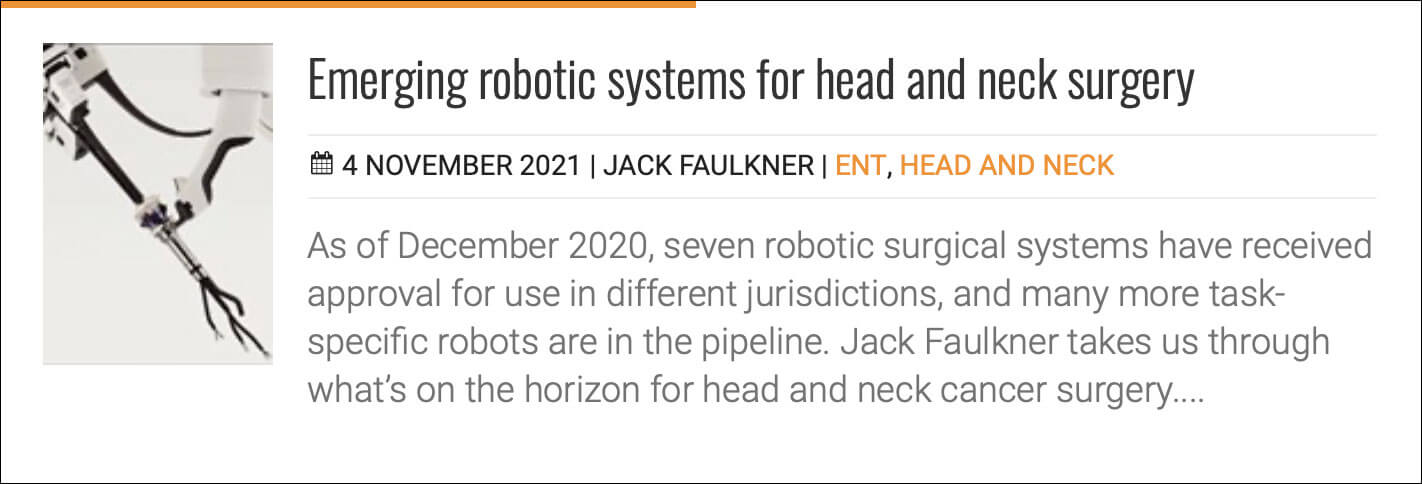In 2021, training in head and neck cancer surgery would be incomplete without some robotic resections under the belt. Henry Zhang explains how he did it and outlines the options available.
With a wide range of applications in both benign and malignant head and neck disease, robotic surgery has replaced many of the traditional open approaches. How do trainees get exposure and training in this technique?
First reported in 2005 as an approach to excise a vallecular cyst [1], robotic surgery in head and neck has since seen a rapid evolution as a primary technique in removing tumours of the oropharynx, hypopharynx and larynx, in thyroid surgery using transoral, transaxillary and post-auricular approaches, in surgery for obstructive sleep apnoea, as well as novel approaches to the parapharyngeal and other deep neck spaces [2]. Its safety and efficacy have been widely demonstrated in the literature, and morbidity is generally more favourable to traditional open approaches eliminating scars, reducing fistula rates, and preserving function [3,4]. The most common approach is through the mouth, termed transoral robotic surgery (TORS), and it is what we will focus on in this article. The rapid adoption of TORS means it now forms a part of the curriculum in many otolaryngology residency programmes in the USA, though in the updated 2021 UK Intercollegiate Surgical Curriculum, robotics is not mentioned for otolaryngology, and only forms part of the basic science knowledge for maxillofacial surgery (www.iscp.ac.uk/iscp/curriculum).
How is a robotic head and neck procedure performed?
To understand the training involved, we must first examine the set-up of a robotic head and neck procedure. The most common robotic-assisted system used is the da Vinci series (Intuitive). This is made up of three components: the patient cart, the surgeon console, and the vision cart.
The patient cart and vision cart
Sitting at the head end of the patient, this has up to four robotic arms that hold the 3-dimensional high-definition (3DHD) endoscope and accompanying surgical instruments. A scrubbed surgical assistant and scrub nurse are at the patient cart, providing retraction, suction and ensuring instruments do not injure or damage structures in motion. The vision cart provides the assistant and scrub nurse with the view the main surgeon has of the field.
“Video game proficiency may have a positive effect on surgical ability, and anyone who has played a virtual reality video game will certainly feel familiar during these simulation games”
The surgeon console(s)
The main surgeon sits at the console and is able to visualise the surgical field in 3DHD, manipulating wristed instruments on each of the four arms. Most centres will provide two consoles, with control being interchangeable, which is of vital importance in providing and receiving training. At the console, the surgeon can speak to the assistant and scrub nurse through a microphone heard at the patient cart.
What is the process of training in robotic surgery?
Training in robotic head and neck surgery begins with mandatory didactic learning in how the system technology works. Intuitive have an online programme which is available through all centres that offer their integrated system. Trainees must complete this training and the assessment before assisting in procedures. Once done, it is advised that trainees undergo simulation training. This uses virtual instruments from the surgeon’s console to familiarise oneself with the visualisation and controls. Skills range from placing hoops on poles, to simulation of surgical procedures with or without guidance. It is well known that video game proficiency may have a positive effect on surgical ability, and anyone who has played a virtual reality video game will certainly feel familiar during these simulation games.
“Assisting in TORS procedures is a role that cannot be overemphasised, allowing the trainee to apply their coordination skills from simulation”
The Fundamentals of Robotic Surgery is a widely recommended educational programme for training and assessment in robotic surgical skills for all subspecialties (https://frsurgery.org/). It offers the novice robotic surgeon a structured curriculum introducing surgical robotic systems, operative setup, psychomotor, team training and communication skills. In their proposal for a curriculum in TORS, Weinstein et al set out a structured programme for their residents [5]. The authors performed a literature review of robotic surgical training in all subspecialties and mirrored their curriculum to similar methods used in urology, general surgery and gynaecology.
The programme starts with didactics and simulation, followed by cadaveric training in a skills lab and, finally, intraoperative skills development. The latter begins with active observation in the operating theatre, where the trainee will understand the anaesthetic set-up, equipment and patient positions. The trainee should actively observe the assistant and the surgeon, then begin bedside assisting, where they learn cart positioning, arm and camera positioning, retraction and clip application. Assisting in TORS procedures is a role that cannot be overemphasised, allowing the trainee to apply their coordination skills from simulation as well as providing insight to what is needed for the surgeon at the console.
The ideal console training will involve the supervisor sitting at the main console, with the trainee at a second console. This master-slave set-up of two consoles is unique in surgical training, as it allows the trainer to point out structures and take over and hand back the controls at any time. In this way, different steps of the procedure can be performed by both surgeons in turn with smooth transitioning, and procedures can therefore be broken down into steps of varying difficulty. Furthermore, as both surgeons have the exact same view of the field, this eliminates uncertainty of either surgeon’s view, and the ability to point out using augmented reality means the field is never disturbed during these teaching scenarios.
What is the process of TORS training in the UK?
Given that many centres in the UK are offering TORS now as standard treatment, ENT trainees across the country will no doubt get exposure to these procedures during their rotations. My personal experience started in a sleep surgery unit, which then brought me somewhat fortuitously to Forli in Italy, where I managed to observe robotic surgery in action in an internationally recognised, high-output centre. This was followed by a year of head and neck training at the Royal London Hospital where I assisted and first performed procedures at the console, and then the Royal Marsden Hospital for my final year prior to CCT, where I further developed skills in TORS in both the primary and recurrent cancer settings.
“Having a good handle on open surgery helps understanding the structures that one will be close to when approaching from ‘inside-out’”
It goes without saying that a detailed understanding of anatomy is vital when first undertaking these procedures. Having a good handle on open surgery helps understanding the structures that one will be close to when approaching from ‘inside-out’. That being said, specific textbook chapters, videos and journal articles that describe and show these procedures in detail are widely available and should be studied in detail by the trainee. In terms of skills, the most transferable skills are probably from transoral procedures (never underestimate tonsillectomy!) and any minimally invasive procedure. Those with prior experience in laparoscopic surgical procedures may recognise the similarities in using these instruments.
For trainees interested, there are courses tailored towards training specifically in TORS around the world. Unfortunately, due to the COVID-19 pandemic, many workshops and courses have been on hold. However, in the UK, the two-day intensive TORS dissection course in Newcastle has been running for six years, and offers hands-on cadaveric dissection. For more information on this please contact louise.sore@nhs.net.
References
1. McLeod IK, Melder PC. Da Vinci robot-assisted excision of a vallecular cyst: a case report. Ear Nose Throat J 2005;84(3):170-2.
2. Cammaroto G, Stringa LM, Zhang H, et al. Alternative Applications of Trans-Oral Robotic Surgery (TORS): A Systematic Review. J Clin Med 2020;9(1):201.
3. de Almeida JR, Byrd JK, Wu R, et al. A systematic review of transoral robotic surgery and radiotherapy for early oropharynx cancer: a systematic review. Laryngoscope 2014;124(9):2096-102.
4. Paleri V, Fox H, Winter S. Transoral Robotic Surgery for Oropharyngeal Cancer. ORL J Otorhinolaryngol Relat Spec 2018;80(3-4):156-70.
5. Sperry SM, O’Malley Jr BW, Weinstein GS. The University of Pennsylvania Curriculum for Training Otorhinolaryngology Residents in Transoral Robotic Surgery. ORL 2014;76(6):342-52.





